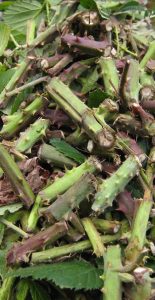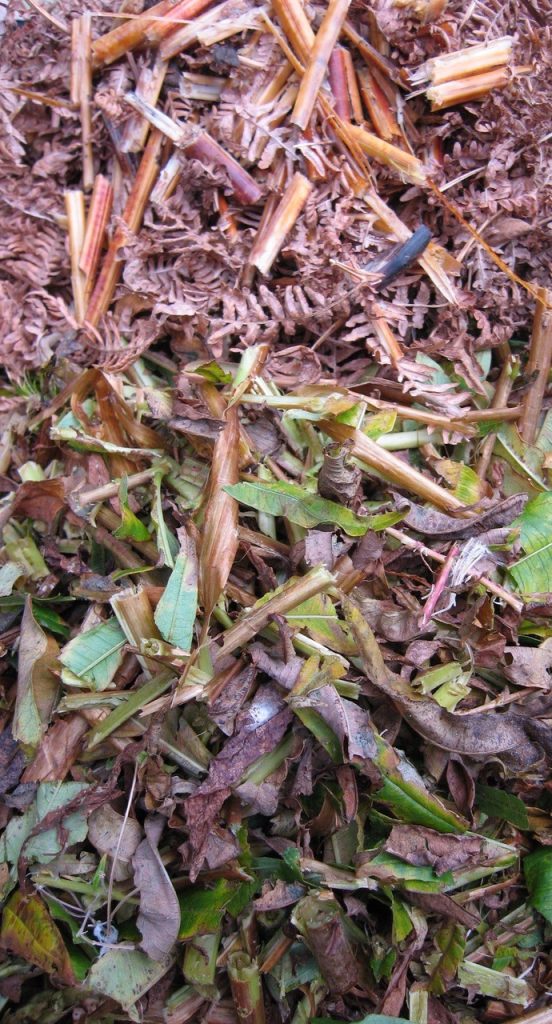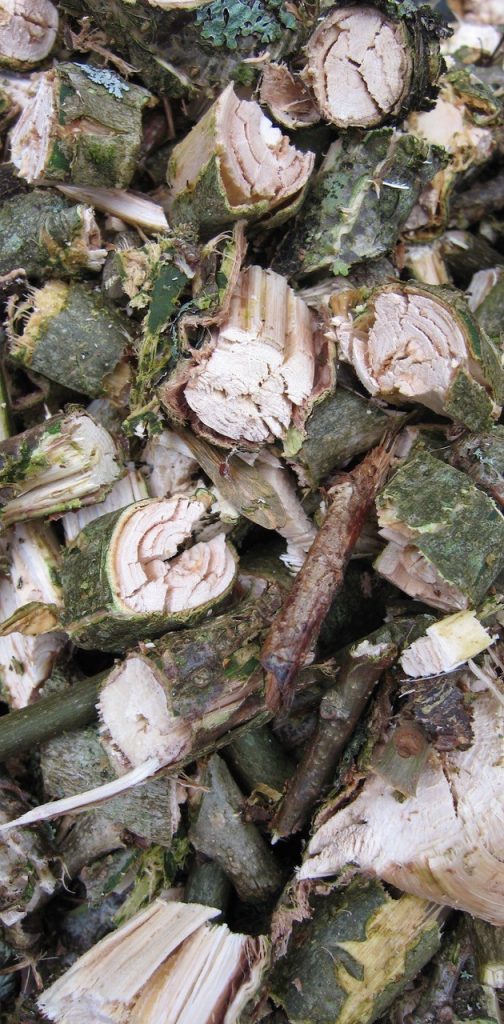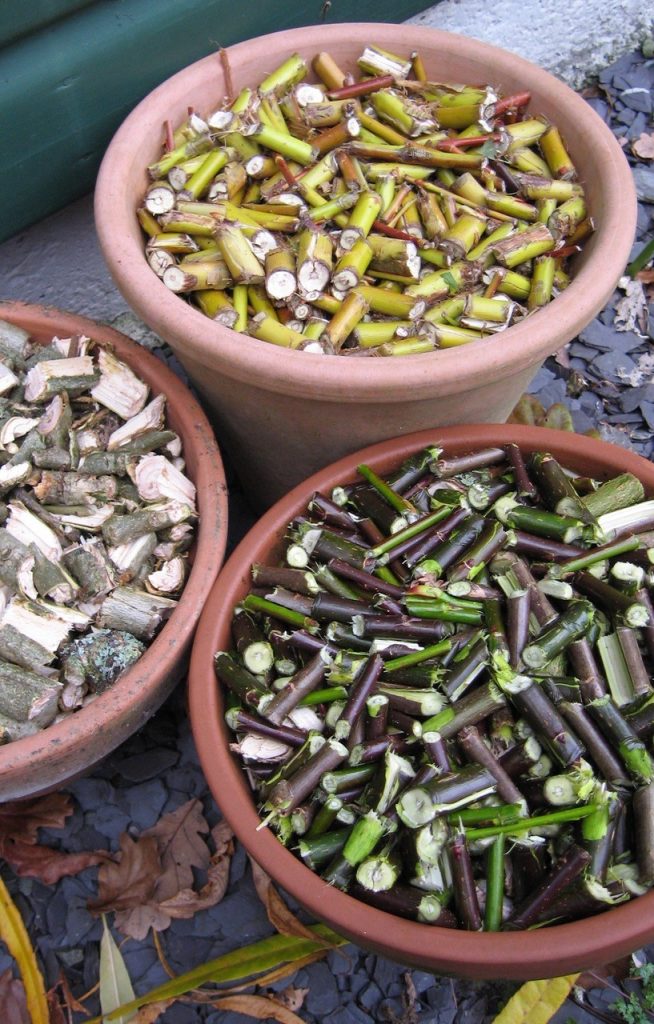Close the loop: a modest, well-mannered shredder can convert tough green ‘waste’ into mulching magic, and let you keep all of your garden’s fertility on site.
I’ve just been absorbed in a day of magical, hands-on fun in balmy autumn sunshine. Serenaded by a gentle clatter of falling oak leaves, and by the sudden, startling squawks of jays, the musty air is ripe with decay. There’s a sense of ending, and hints of winter’s restfulness ahead. Gardening’s rush months are finally over: phew. Now’s the time of year when I get to play around with new ideas, and to experiment with all that exciting stuff that spring and summer’s frenetic pace pushes to the bottom of my must-try list. The first sparkling morning after a dahlia-blackening frost is always melancholic, but it’s also when my garden dreaming – and future scheming – begins.

The focus of my current scheming involves armfuls of fading perennial plant stems, bundles of golden bracken fronds, a stack of woody ash, hazel, oak and willow trimmings, some rosebay willowherb, and a swirling pile of merciless uprooted brambles. They might sound like the ingredients for a bonfire par excellence, but I have far more productive and massively less wasteful, less polluting and less neighbour-annoying plans for them all. Alongside gauntlets and loppers, I have one heavyweight piece of renewable electricity-powered kit to help me bring this plotting to fruition: my shredder.
Much of my long-term gardening thinking now revolves around my Makita UD2500. It’s a ‘quiet’ shredder, meaning it cuts and crushes fresh plant material (up to 45mm/1.7in in diameter) into chunks, rather than smashing it to smithereens via a fast-moving noisy blade; there’s already enough tedious, intrusive noise pollution generated by our gardening activities (think leaf blowers and whining strimmers) and I don’t want to louden it. My machine isn’t noise-free, but its low rumble is unlikely to bump up anyone’s BP.
I’m so wrapped up in imagining the ways in which my shredder can help me make my garden more earth- and climate-friendly that it’s become something of an obsession. I’ll let you into a sad secret: I lie in bed at night dreaming up ways of putting its alchemical properties to good use. There is a genuine element of magic at play when you start using a shredder. Those annoying, hard-to-handle piles of woody prunings, and the tough stems of herbaceous plants and weeds, can be transformed, in minutes, all year round, into something manageable and ultimately useful. Time- and fuel-hungry trips (perhaps involving numerous plastic sacks) to your ‘waste recycling centre’, or jumping up and down on your ‘garden waste’ wheelie bin, are soon history. With a shredder, and a tad of forethought, ‘waste’ quickly becomes a dirty gardening word.

I’m already using my shredder’s transformative power to boost the fertility of the soil throughout my garden, using ‘chipped branch wood’. Deploying everyday woody prunings to boost microbial soil life, and to help build earth’s own mycelial internet, is rewarding me with some of the healthiest plants I’ve ever grown. To boot, I’m also sinking the carbon bound up in those shreddings deep into the soil, where it gets locked down tight.
But I dream of doing more – and of wasting nothing.
One literally thorny problem my shredder obsession has solved is what to do with an abundance of that wildlife-friendly, delicious but vicious weed, the bramble. As my patch is a bonfire-free zone, I’ve taken to rolling its stems up into balls, then ‘losing’ them in the adjacent woodland. But even this seemed a nagging waste, so now those leg-lacerating stems are fed carefully into the shredder (watch out for whiplash). Then, added to an extra-long-term compost heap, even the most spiteful thorns eventually crumble to black gold. Anything else thorny – hawthorn, blackthorn, raspberry canes, roses – joins the brambles in their slow-rot pile. Faster rotters, such as the green stems of herbaceous perennials, can go straight from shredder to compost heap, where they’re mixed in with everything else.
Two other weeds here provide an abundance of useful (and annually renewing) material that’s manna for shredding. The only thing more satisfying than feeling a bracken frond snap away from its underground rhizome, during a regular ‘pull’ session, is feeding a bunch of uprooted fronds into the hopper. Tough it may be, but Pteridium aquilinum is quickly transformed into a long-lasting, weed-smothering and soil-feeding mulch. Thanks to my Makita, I’ll never have to buy (or fetch) bagged mulch again.

Another prodigious and home-grown mulch-maker is rosebay willowherb. While it delights the bees in my garden’s hinterland, I’d like to keep it on the other side of my fence. Its long, tough stems used to be pulled up each autumn, joining the bramble for woodland disposal, but I’ve discovered they shred beautifully (minus the fluffy, seed-bearing heads) into mulch mix. As an added bonus, the shredder gobbles up their long straight stems with ease. If I’m adding chopped rosebay to my compost-making, I snap off any bits of obviously live root at the base of the stems first (they go into the weed-drowning butt).
Although it makes short shrift of thinner, softer stems, my shredder slows down a little to crush and chew its way through woodier prunings, such as ash and oak. Recent storms have downed a few branches laden with shoots up to an inch thick, which are ideal for transforming into tough, good-looking and hard-wearing paths. I’ll use these to top up existing paths, and to make new ones. These big, chunky chips of wood will also be used as a thick surface winter mulch around my rapidly departing dahlias. Mild winter permitting, they’ll help to insulate the tubers from bursts of fatal frost. Like all dry, chunkier mulches, wood chips also provide habitat for surface-dwelling wildlife; dashing wolf spiders love to duck and dive over them.

Mulching here isn’t confined to the outdoor garden. The ornamental willows I planted for their colourful stems, to use for winter weaving, are now growing like billy-o. As well as the whippier shoots, I now have chunkier stems sporting the same rich-coloured bark. Chopped up, these are destined for a try-out as natural-looking ‘pot-top’ mulch for my terracotta pots of tulips, which will come into my unheated greenhouse during winter’s darkest and wettest days. When the tulips and other bulbs have bowed out, the willow chunks can go for composting, go onto the beds as mulch, or be used to top up paths. I could get into this colour-scheming with pot-top mulches. How about plain terracotta containers planted with dwarf, spring-flowering blue iris, topped with shredded yellow-stemmed willow (or dogwood)? For narcissi, I could swap yellow shreddings for black. I did say this was obsessive.
Spreading wood chips over beds in a greenhouse or polytunnel will stop the soil from drying out during winter (it’s easy to forget it never rains under cover). Come spring, the shreddings (along with some fresh ones) can be forked into the top few inches of soil, to help invigorate it. Then you can shred any spring prunings (any colour will do) to deploy as weed-deterring, moisture-trapping summer mulch. Next autumn, you can do it all over again.
Saying goodbye to waste, to pollution, to exporting valuable resources away from your patch, while at the same time improving the look, functionality and fertility of your garden – what’s not to like? It’s time to join me in shredder heaven. Let’s get scheming.
Text and images © John Walker
Find John on Twitter @earthFgardener










